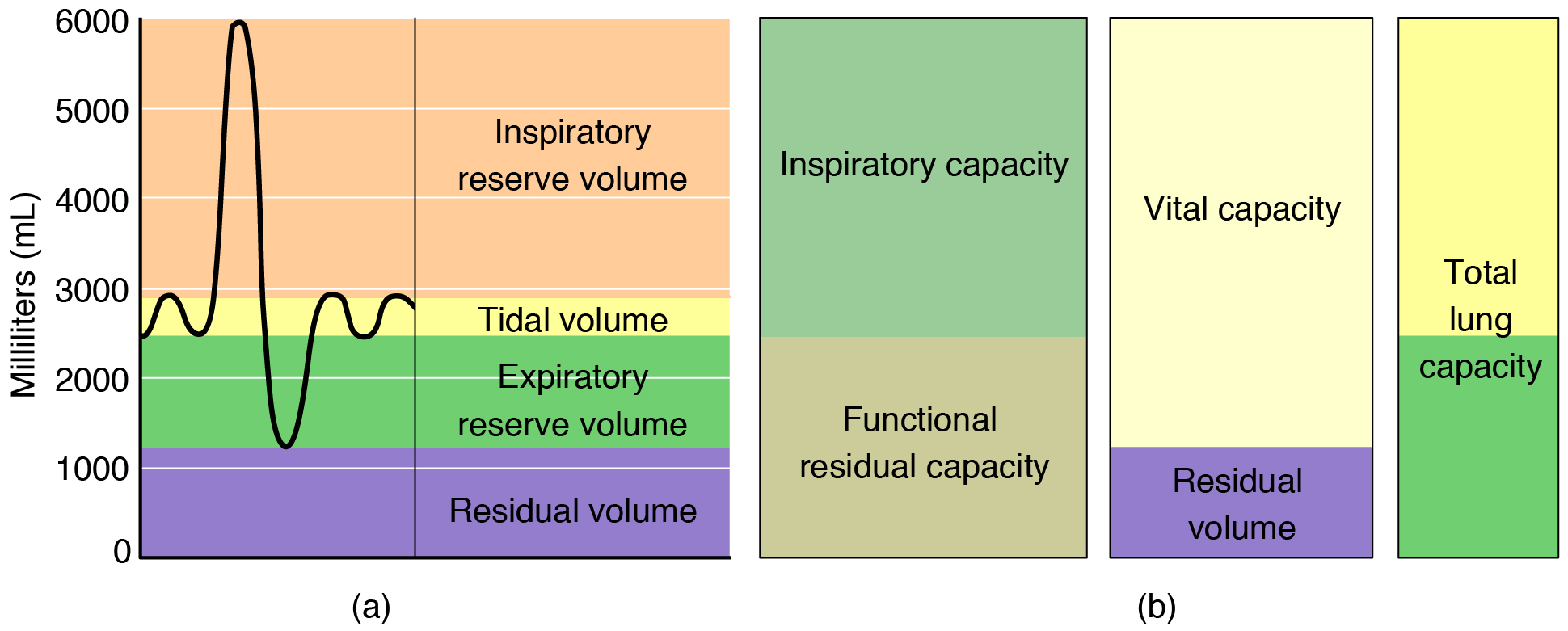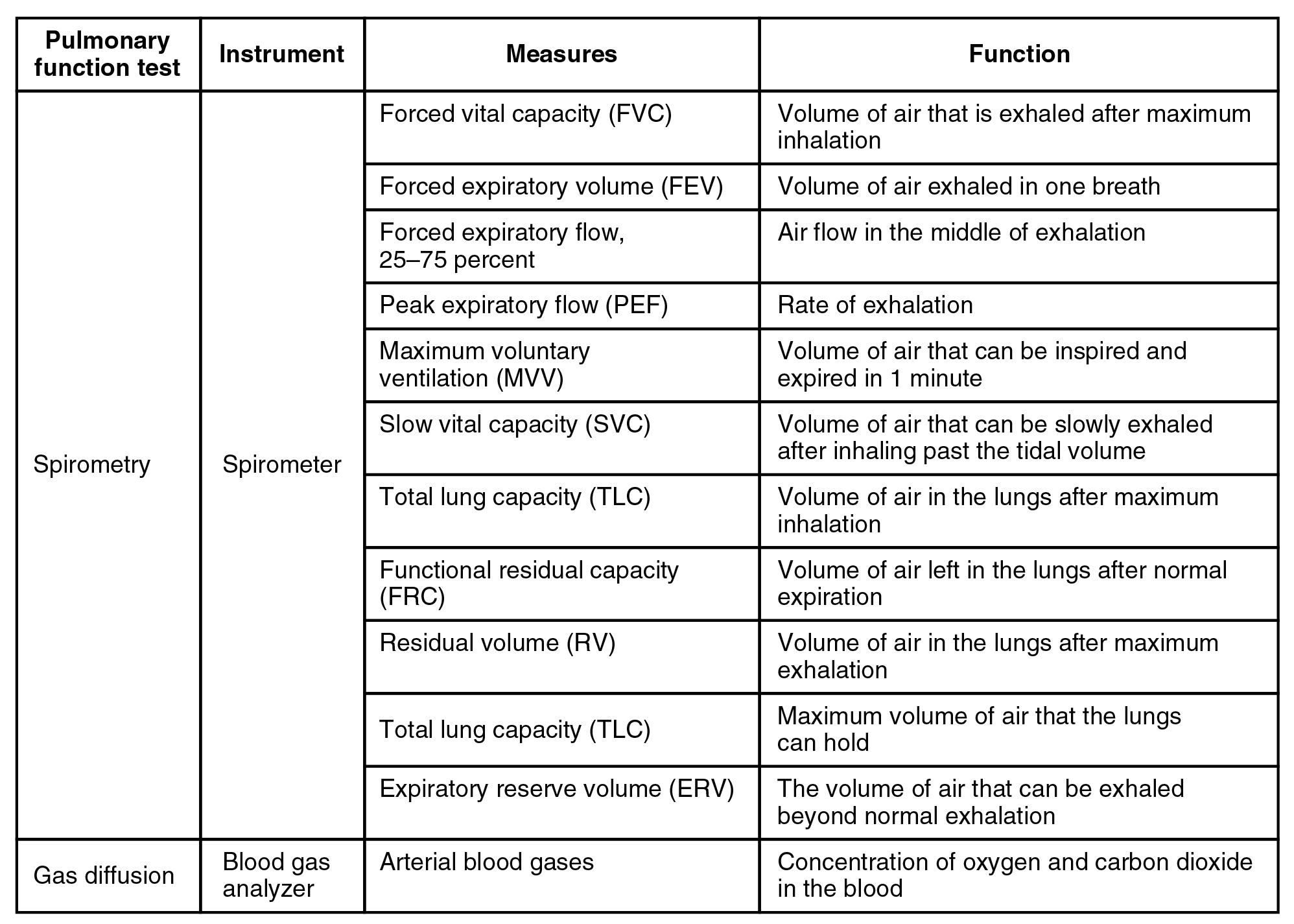64 Pulmonary volumes and capacites
Learning Objectives
After reading this chapter, you should be able to-
- Define, identify, and determine values for the pulmonary volumes (inspiratory reserve volume [IRV], tidal volume [TV], expiratory reserve volume [ERV], and residual volume [RV]) and the pulmonary capacities (inspiratory capacity [IC], functional residual capacity [FRC], vital capacity [VC], and total lung capacity [TLC]).
Respiratory volume is the term used for various volumes of air moved by or associated with the lungs at a given point in the respiratory cycle. There are four major types of respiratory volumes: tidal, residual, inspiratory reserve, and expiratory reserve (Figure 63.1). Tidal volume (TV) is the amount of air that normally enters the lungs during quiet breathing, which is about 500 milliliters. Expiratory reserve volume (ERV) is the amount of air you can forcefully exhale past a normal tidal expiration, up to 1200 milliliters for men. Inspiratory reserve volume (IRV) is produced by a deep inhalation, past a tidal inspiration. This is the extra volume that can be brought into the lungs during a forced inspiration. Residual volume (RV) is the air left in the lungs if you exhale as much air as possible. The residual volume makes breathing easier by preventing the alveoli from collapsing. Respiratory volume is dependent on a variety of factors, and measuring the different types of respiratory volumes can provide important clues about a person’s respiratory health (Figure 63.2).


Figure 63.2 describes methods of pulmonary function testing. Spirometry tests require a spirometer. These tests can measure forced vital capacity (FVC), the volume of air that is exhaled after maximum inhalation; forced expiratory volume (FEV), the volume of air exhaled in one breath; forced expiratory flow, 25 to 75 percent, the air flow in the middle of exhalation; peak expiratory flow (PEF), the rate of exhalation; maximum voluntary ventilation (MVV), the volume of air that can be inspired and expired in 1 minute; slow vital capacity (SVC), the volume of air that can be slowly exhaled after inhaling past the tidal volume; total lung capacity (TLC), the volume of air in the lungs after maximum inhalation; functional residual capacity (FRC), the volume of air left in the lungs after normal expiration; residual volume (RV), the volume of air in the lungs after maximum exhalation; total lung capacity (TLC), the maximum volume of air that the lungs can hold; and expiratory reserve volume (ERV), the volume of air that can be exhaled beyond normal exhalation.
Respiratory capacity is the combination of two or more selected volumes, which further describes the amount of air in the lungs during a given time. For example, total lung capacity (TLC) is the sum of all of the lung volumes (TV, ERV, IRV, and RV), which represents the total amount of air a person can hold in the lungs after a forceful inhalation. TLC is about 6000 mL air for men, and about 4200 mL for women. Vital capacity (VC) is the amount of air a person can move into or out of his or her lungs, and is the sum of all of the volumes except residual volume (TV, ERV, and IRV), which is between 4000 and 5000 milliliters. Inspiratory capacity (IC) is the maximum amount of air that can be inhaled past a normal tidal expiration, and is the sum of the tidal volume and inspiratory reserve volume. On the other hand, the functional residual capacity (FRC) is the amount of air that remains in the lung after a normal tidal expiration; it is the sum of expiratory reserve volume and residual volume (Figure 63.1).
Adapted from Anatomy & Physiology by Lindsay M. Biga et al, shared under a Creative Commons Attribution-ShareAlike 4.0 International License, chapter 22
various volumes of air moved by or associated with the lungs at a given point in the respiratory cycle
volume of air that normally enters the lungs during quiet breathing
volume of air that can be forcefully exhaled following a normal expiration
volume of air that can be inhaled following a normal inspiration
volume of air left in the lungs following a maximal exhalation
the sum of all lung volumes; the total amount of air that can be held in the lungs following maximal inspiration
the maximum amount of air that can be expired following a maximal inspiration, equal to the sum of: tidal volume, expiratory reserve volume, and inspiratory reserve volume
maximal amount of air that can be inspired following a normal (tidal) expiration; equal to the sum of: tidal volume and inspiratory reserve volume
amount of air left in the lungs following a normal (tidal) expiration; equal to the sum of: expiratory reserve volume and residual volume

